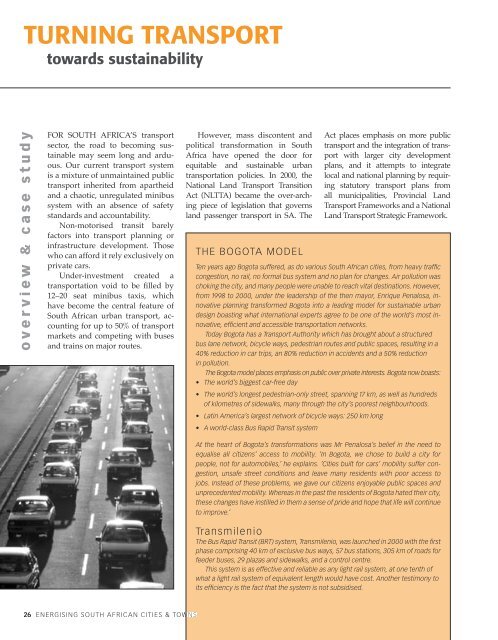Energising South African Cities & Towns - City Energy Support Unit
Energising South African Cities & Towns - City Energy Support Unit
Energising South African Cities & Towns - City Energy Support Unit
Create successful ePaper yourself
Turn your PDF publications into a flip-book with our unique Google optimized e-Paper software.
TURNING TRANSPORTtowards sustainabilityo v e r v i e w & c a s e s t u d yFOR SOUTH AFRICA’S transportsector, the road to becoming sustainablemay seem long and arduous.Our current transport systemis a mixture of unmaintained publictransport inherited from apartheidand a chaotic, unregulated minibussystem with an absence of safetystandards and accountability.Non-motorised transit barelyfactors into transport planning orinfrastructure development. Thosewho can afford it rely exclusively onprivate cars.Under-investment created atransportation void to be filled by12–20 seat minibus taxis, whichhave become the central feature of<strong>South</strong> <strong>African</strong> urban transport, accountingfor up to 50% of transportmarkets and competing with busesand trains on major routes.However, mass discontent andpolitical transformation in <strong>South</strong>Africa have opened the door forequitable and sustainable urbantransportation policies. In 2000, theNational Land Transport TransitionAct (NLTTA) became the over-archingpiece of legislation that governsland passenger transport in SA. TheTHE BOGOTA MODELAct places emphasis on more publictransport and the integration of transportwith larger city developmentplans, and it attempts to integratelocal and national planning by requiringstatutory transport plans fromall municipalities, Provincial LandTransport Frameworks and a NationalLand Transport Strategic Framework.Ten years ago Bogota suffered, as do various <strong>South</strong> <strong>African</strong> cities, from heavy traffi ccongestion, no rail, no formal bus system and no plan for changes. Air pollution waschoking the city, and many people were unable to reach vital destinations. However,from 1998 to 2000, under the leadership of the then mayor, Enrique Penalosa, innovativeplanning transformed Bogota into a leading model for sustainable urbandesign boasting what international experts agree to be one of the world’s most innovative,effi cient and accessible transportation networks.Today Bogota has a Transport Authority which has brought about a structuredbus lane network, bicycle ways, pedestrian routes and public spaces, resulting in a40% reduction in car trips, an 80% reduction in accidents and a 50% reductionin pollution.The Bogota model places emphasis on public over private interests. Bogota now boasts:• The world’s biggest car-free day• The world’s longest pedestrian-only street, spanning 17 km, as well as hundredsof kilometres of sidewalks, many through the city’s poorest neighbourhoods.• Latin America’s largest network of bicycle ways: 250 km long• A world-class Bus Rapid Transit systemAt the heart of Bogota’s transformations was Mr Penalosa’s belief in the need toequalise all citizens’ access to mobility. ‘In Bogota, we chose to build a city forpeople, not for automobiles,’ he explains. ‘<strong>Cities</strong> built for cars’ mobility suffer congestion,unsafe street conditions and leave many residents with poor access tojobs. Instead of these problems, we gave our citizens enjoyable public spaces andunprecedented mobility. Whereas in the past the residents of Bogota hated their city,these changes have instilled in them a sense of pride and hope that life will continueto improve.’TransmilenioThe Bus Rapid Transit (BRT) system, Transmilenio, was launched in 2000 with the fi rstphase comprising 40 km of exclusive bus ways, 57 bus stations, 305 km of roads forfeeder buses, 29 plazas and sidewalks, and a control centre.This system is as effective and reliable as any light rail system, at one tenth ofwhat a light rail system of equivalent length would have cost. Another testimony toits effi ciency is the fact that the system is not subsidised.26 ENERGISING SOUTH AFRICAN CITIES & TOWNS












